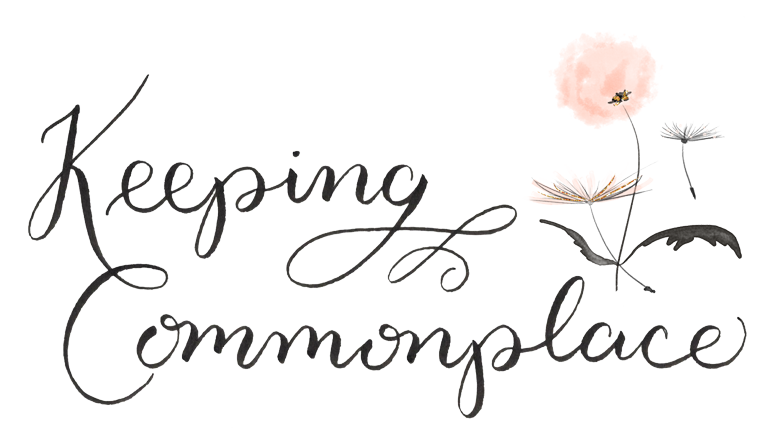Hello Friend and Welcome to Keeping Commonplace!
The word commonplace can be defined several ways and both are extremely fitting for our purposes:
COM·MON·PLACE
-
a (noun) : a usual or ordinary thing, everyday event, routine.
b (adjective) : something commonly found
- archaic: a notable quotation copied into a commonplace book
I think it is safe to say that when most people hear the word commonplace, they think of it as:
A usual or ordinary thing, everyday event, routine.
Beauty abounds in the commonplace. The glory of the Divine Artist is radiating forth from all He has made and yet; somehow, we are blind to the majesty right in front of our noses. We miss it! I miss it.
After all, we have seen it all before.
It is just another sunrise, additional drops of dew glittering on the grass, one more majestic mountain, waves crashing on the sand again. What is even more convicting is just another new day to live, additional babies to change, one more mountain of laundry to fold, meals to prepare yet again.
We have grown so accustomed to the abundant blessings poured out in our lives that we have become jaded, bored and unimpressed.
In fact, traditional usage of the word “commonplace” betokens a blasé expression of disinterested boredom at best. A cursory glance at the dictionary’s list of words asserted to be synonymous include gems like unexceptional, average, mediocre, lackluster, dull, bland, prosaic and (my favorite) pedestrian. One can almost feel the sting of insult, the unmasked disdain for the sheer ordinariness of commonplace things and commonplace days per Miriam-Webster.
G.K. Chesterton’s super sleuth, Fr. Brown, provides an insight as true for solving this mystery as any other, simply that
A thing can sometimes be too close to be seen.”
We are missing so much in casting aside all that is not immediately perceived to be exciting or splendid as so many worthless weeds.
Nothing is commonplace for those who have eyes to see.
And so, we refocus and look again. In this sense, Keeping Commonplace is a conscious choice to say a resounding “Yes!” to that which I am tempted to disregard as mundane or rush by too busy to notice.
I choose to take a step back, slow down and pay attention, to look carefully and change my perspective in all of the repetitious and seemingly worthless tasks that are so much a part of my days as a wife and mother. It is cultivating clarity, awakening awe, beholding beauty, and reclaiming radiance.
It is praying that Christ who healed the blind man will put to flight my blindness too so that I might not just look but truly see the extraordinary in my ordinary, the beautiful in my commonplace and be able to cry out with the unbridled enthusiasm of a little child, “Again!”
I have to be honest with you friend and admit that I am blind to so much of the commonplace beauty around me; but, I do believe it is there and I want to see it with all that is in me. That is a start.
After all,” Anne had said to Marilla once, “I believe the nicest and sweetest days are not those on which anything very splendid or wonderful or exciting happens but just those that bring simple little pleasures, following one another softly, like pearls slipping off a string.” ― L.M. Montgomery, Anne of Avonlea
Though less widely known, Keeping Commonplace, defined as:
a notable quotation copied into a commonplace book
is certainly the more obvious application and is in fact exactly what you can expect to find here. This space is a participation in the art of Keeping Commonplace as a means of recording, remembering and being transformed by the power of words. It is a way to sit up and pay attention to what is being read, to listen more carefully to what is being proclaimed, to linger longer over that which impacts, and to write it slowly for the words to sink in deep.
Whether it be quoting the words of an author, saint, musician, preacher, poet, podcaster or friend. I believe that words are worth remembering.
Established in a time when books were scarce and cost prohibitive, those who could read and write would gather together words they wanted to remember, have as their own and return to for reference by writing them out by hand into a commonplace book. The popularity of commonplacing soared during the Renaissance when books became more readily available and literacy more accessible. By the seventeen hundreds, it was considered an essential element of higher learning and was required of scholars at Harvard and Oxford.
They were treasured possessions often kept on one’s person so as not to miss an opportunity to capture bits of wisdom as they arose. Although recording quotes of others, commonplace books were an extremely personal documentation of the life, thought and learning of those who kept them. They were returned to frequently and often known by heart to be applied to public speaking, science, writing, endeavors of business, creativity, and life itself. As such, they were highly valued family heirlooms often passed down from one generation to the next and listed in dowries. Museums and library archives to this day hold the commonplace books kept by people of influence.
This is my commonplace book.
My hope is that by reclaiming and keeping the practice of so many great thinkers and artists who have gone before, we too will cultivate eyes capable of beholding beauty not only on a page but also in the seemingly ordinary all around us.

Warning: count(): Parameter must be an array or an object that implements Countable in /home/dp66iirvwlf2/domains/keepingcommonplace.com/html/wp-includes/class-wp-comment-query.php on line 405






